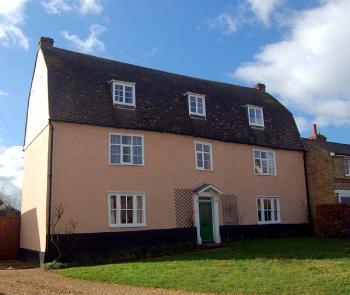Military and Civil Defence in Potton in World Wat Two
The Bedfordshire Historic Environment Record [HER] contains information on the county’s historic buildings and landscapes and summaries of each entry can now be found online as part of the Heritage Gateway website. The material shows that World War Two left quite an impression on Potton.
On the side of the road from Deepdale to Everton was a loading ramp forming part of an ammunition dump [HER 17969]. The ramp is where the ammunition was transferred from lorries to a narrow gauge railway for transfer to the woods where it was stored. There were originally four such ramps and the single track railway included a loop at the Everton Road end where trains could turn round. The railway was used for a year before being replaced by lorry relays.
A military camp lay at Potton Manor [HER 17965]. Today a street called The Manor occupies the site. The camp was later used as a prisoner-of –war compound.
A number of tank traps were positioned around the parish. These were either concrete blocks or steel angle irons designed to prevent the progress of vehicles including lorries, armoured personnel carriers, armoured cars and tanks. The HER lists the following locations:
- Just west of Potton Brook Bridge – angle irons [HER 17953];
- At Potton station – brick and reinforced concrete cubes five feet long, broad and high; two more may have been situated opposite the Red Lion [HER 17954];
- On Gamlingay Road - angle irons, of which one was still visible in 1983 [HER 17957];
- On Sandy Road just east of the Deepdale junction – five concrete cubes and angle irons [HER 17958];
- In Everton Road just west of the Willow Road junction – angle irons [HER 17961]
Potton was also the site of a number of pill-boxes. These were concrete strongpoints designed for a small garrison; they would fire small arms or anti-tank weapons from them and so they were sited at strategic points in any anticipated enemy line of advance. The following pill-boxes have been identified:
- A ruined pill-box stands at Hatley Road near the junction of Sutton Road – just the first three courses of brickwork are visible [HER 10688];
- South of Hatley Road near the junction with Church Causeway – brick built and measuring 7 feet 6 inches each side with 18 inch thick walls and a 2 inch thick roof with corrugated iron beneath [HER 10689];
- On Wrestlingworth Road just south of The Baulk [HER 17955];
- Just south of Station Road at The Paddocks [HER 17956];
- South of Myers Road – it is now used as a garden shed for a house in Bayards Green [HER 17960];
- At Brook End on the east side of the modern Brookfields [HER 17962];
- On Everton Road just opposite the junction with The Heath - it was situated on a slope and sunk well into the ground with only the gun slots visible [HER 17964]
- A former pill box on Potton Road just west of the Deepdale junction – blown up by the army early in the war [HER 17968];
- Deepdale - a portable pillbox with a steel turret [HER 17970]
Some places in Potton had spigot mortar bases installed. The mortar had a firing mechanism at the rear and was attached to the swivel base, often with a trench around the base to give the firing team some protection. Mortars were a simple form of light artillery used to break up infantry attacks or drop smoke to obscure the battlefield.
- On Gamlingay Road [HER 17950];
- Just north of Myers Road west of the junction with Common Road [HER 17951];
- On Biggleswade Road nearly opposite the football ground [HER 17963].
A number of properties in Potton were used for civil defence in World War Two. , home of Doctor Anderson, was used as a Rescue Party depot and was later upgraded as a First Aid Point [WW2/AR/CA/1/1/4]. Home Farm in Horne Lane was owned by the Land Settlement Association Limited and tenanted by A. C. Andrews. It was used as an ARP Wardens’ post from April 1941 [WW2/AR/CA/1/1/4 and WW2/AR/C/2/103]. Another Wardens’ Post was established in the Market Square in a purpose brick-built structure, relinquished to Bedfordshire County Council in April 1946 [WW2/AR/CA/1/1/4 and WW2/AR/C/2/255]. The Chequers Inn at Brook End was used for garaging an ambulance from May 1944 [WW2/AR/C/2/234].

The former Chequers March 2007